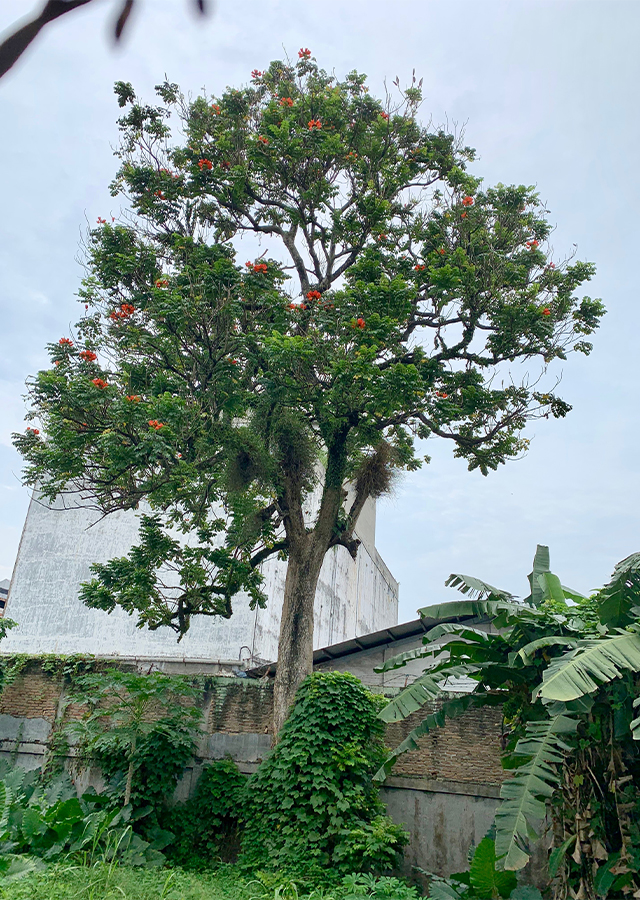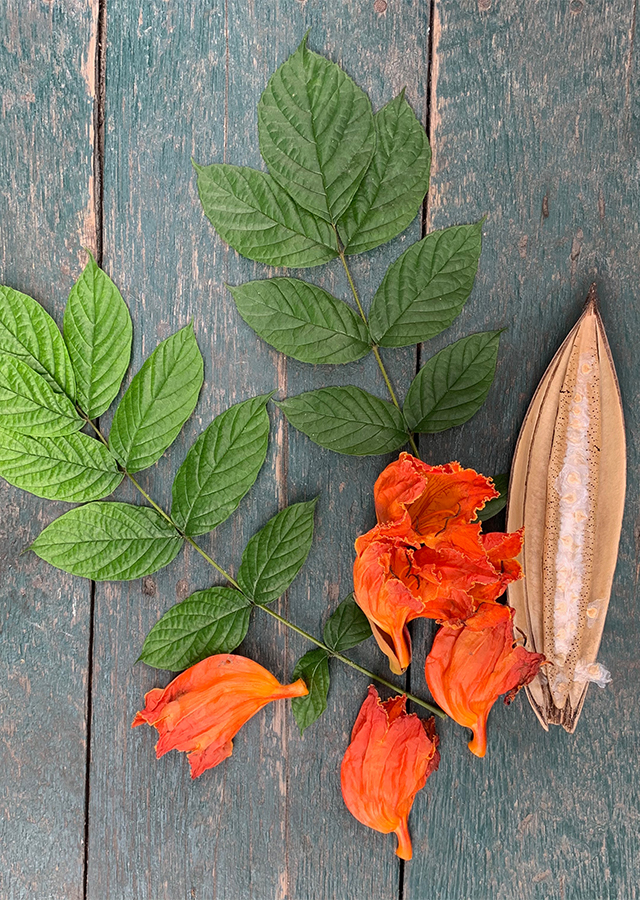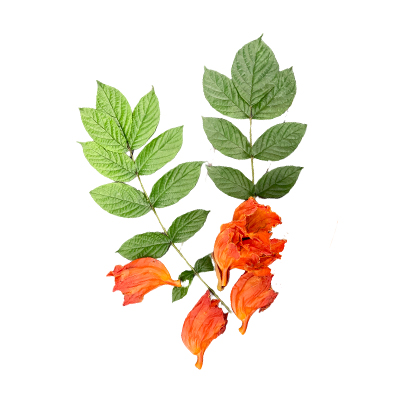African Tulip Tree
Spathodea campanulata P.Beauv.
Bignoniaceae
Location in our garden
Principal



Synonym
Spathodea danckelmaniana Büttner
Spathodea nilotica f. bryanii O.Deg. & I.Deg.
Spathodea tulipifera (Schum.) G.Don
Habitus
Trees. A medium-sized to large perennial tree up 25 to 35 m tall and 175 cm in diameter. As a popular ornamental tree, it is highly likely to be further introduced intentionally and to be spread nationally as planting stock.
Part Used
Leaves
Bark
Flowers
Fruit
Roots
Stem
Growing Requirements
Full Sunshine
Drought Resistant
Habitat
Forest
Coastal
Roadside
Shrublands
Terrestrial
Overview
African tulip tree (Spathodea campanulata) is widely and commonly known as the African tulip tree, and has been introduced pan-tropically for its ornamental value. It is invasive in many countries, mostly tropical islands in the Pacific, Indian and Caribbean, but also Singapore, Papua New Guinea, and Australia. It is considered an invasive species and a weed in many countries. Where introduced, it invades both abandoned agricultural land and closed forest and has become a weed in abandoned pasture sites, where it may become dominant. However, it also has much utilization as a medicinal plant.
Vernacular Names
Kecrutan (Indonesia), Tulipier du Gabon (French), Kae sàet (Thailand), Amapola (Spanish), Sirit-sirit (Tagalog-Philippines), Huo yan mu (Chinese), Kaenboku (Japanese).
Agroecology
A plant of the tropics, where it is found at elevations up to 2,000 m. The tree is suited to humid conditions and grows well in areas with an even distribution of rainfall, though it will tolerate a dry season of up to six months. Grows best in areas where annual daytime temperatures are within the range of 27 to 30 °C but can tolerate 23 to 34 °C. It prefers a position in full sun, a mean annual rainfall in the range of 1,300 to 2,000 mm, but tolerates 1,000 to 2,400 mm. It grows on a wide variety of sites, from poorly to excessively drained, but prefers fertile, deep, and well-drained loams. Grows best in rich, deep soil, but plants are very tolerant of much poorer conditions.
Morphology
- Roots - taproot with a lot of lateral roots.
- Stem - branches are thick and are marked with small whitish-colored corky spots. Younger branches with small hairs.
- Barks- become hollow, dropping large branches as the tree ages.
- Leaves - opposite or in whorls of 3, imparipinnate, stipules absent, petiole 7–15 cm long, rachis 15–35 cm long.
- Flowers - bisexual, zygomorphic, large and showy; pedicel up to 6 cm long, longer in the lower part of inflorescence than in upper part; calyx spathaceous, 4–8 cm long.
- Fruits - a narrowly ellipsoid woody capsule 15– 27 cm × 3.5–7 cm, blackish-brown, dehiscing by 2 valves, many-seeded.
- Seeds - thin and flat, ca. 1.5 cm × 2 cm, very broadly winged.
Cultivation
- Propagation is mostly by seed. Seeds do not require treatment; they are recalcitrant and their viability is short.
- Cuttings can also be used for propagation, with larger diameter cuttings (up to 10 cm) giving the best results.
Chemical Constituents
Alkaloids, flavonoids, saponins, steroids, terpenoids, tannins, glycoside, sterols, cerebroside, iridoid, ketone, phenols, carboxylic acid, benzyl benzoate, geranyl acetone, β-caryophyllene, farnesyl acetone, aromadendrene, tricosane.
Traditional Medicinal Uses
- Studies have shown antimicrobial, hypoglycemic, antimalarial, wound healing, antifungal, analgesic, anti-inflammatory, nephroprotective, antioxidant, and anticonvulsant properties.
- Extracts of the bark, leaves, and flowers are used to treat malaria, HIV, diabetes mellitus, edema, dysentery, constipation, gastrointestinal disorders, ulcers, skin diseases, wounds, fever, urethral inflammation, liver complaints, and as a poison antidote.
- Cold infusion of leaves is used for urethral inflammation.
- The unopened flower buds contain a sweet, watery liquid that is considered to be tonic.
- The bark is chewed and sprayed over swollen cheeks. The bark may also be boiled in water used for bathing newly born babies to heal body rashes.
- In Africa, the stem bark is used as a paste for wound healing.
- In Cameroon, the plant is used for the treatment of malaria, mental disorders, and hemorrhoids.
Part Used
Reference Sources
- Bosch, C.H. (2002). Spathodea campanulata P.Beauv. Plant Resources of Tropical Africa (PROTA). https://uses.plantnet-project.org/en/Spathodea_campanulata_(PROTA) (Accessed 08-02-2021).
- CABI. (2021). Invasive Species Compendium: Spathodea campanulata (African tulip tree). Centre for Agriculture and Bioscience International (CABI) Web. https://www.cabi.org/isc/datasheet/51139#tosummaryOfInvasiveness (Accessed 08-02-2021).
- Fern, K. (2021). Useful Tropical Plants: Spathodea campanulata. Useful Tropical Plants Database Web. http://tropical.theferns.info/viewtropical.php?id=Spathodea+campanulata (Accessed 08-02-2021).
- Flowers of India. (2021). African Tulip Tree. Flowers of India Web. http://www.flowersofindia.net/catalog/slides/African%20Tulip%20Tree.html (Accessed 08-02-2021).
- Herrera-Isla, L., Brice, L., & Grillo-Ravelo, H. (2002). Methodology for the artificial inoculation with Ceratocystis sp. for the control of Spathodea campanulata Beauv. (Metodología para la inoculación artificial de Ceratocystis sp. para el control de Spathodea campanulata Beauv.) Centro Agrícola 29(3): 56-58.
- Rivera, L.W., & Aide, T.M. (1998). Forest recovery in the karst region of Puerto Rico. Forest Ecology and Management 108: 63–75.
- StuartXchange. (2016). Philippine Medicinal Plants: Sirit-sirit. StuartXchange Web. http://www.stuartxchange.org/TulipTree (Accessed 08-02-2021).
- Villarreal, S., Jaimez, D., & Moreno, S., et al. (2015). Volatile Constituents from the Flowers of Spathodea campanulata from the Venezuelan Andes. Natural Product Communications 10(11): 1999-2000.



